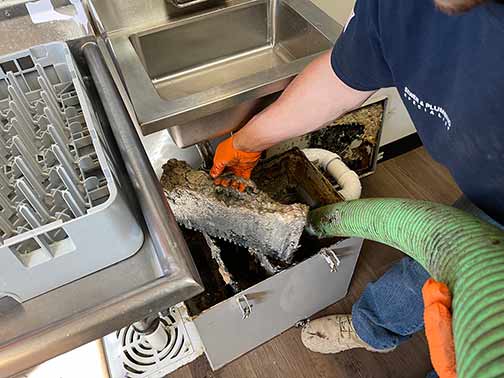
In commercial settings such as restaurants and locations with commercial kitchens, grease traps are an essential feature for managing the fats, grease, and oil (FOG) generated from the premises, says Mike Dunfee Group. City regulations require that such businesses have grease traps installed in their buildings.
The reason is to keep fats, grease, and oil (FOG) from being washed into the drains. FOG poses a threat to both private and public sewer systems. If allowed to enter a kitchen’s drain lines, FOG can clog the pipes, ultimately damaging city infrastructure and polluting the environment.
Grease traps prevent this by capturing the fats, oil, and grease in wastewater from the source. Before wastewater has a chance to enter the drainage system and pollute the environment, the grease trap filters out the fats, oil, and grease inside the water and isolates it in a separate space.
This operation protects the building’s drainage system and public sewer lines, but it creates some problems for the grease trap. After a while, the grease trap becomes full of grease and starts to lose its functionality. To solve this problem, the grease trap must be cleaned periodically, or else.
What happens if you don’t clean a grease trap?
- Grease spills: Grease from an overflowing grease trap may spill over into the surrounding areas, posing problems for the overall sanitation of the premises.
- Safety risk: Grease spills increase the risk of slips, trips, and falls. They create safety hazards that expose your business to lawsuits and other liabilities.
- Unpleasant odors: Due to the decaying organic matter inside it, an overflowing grease trap will emit bad odors. These bad smells can filter into the rest of the facility.
- Loss of revenue: Bad odors and safety issues may cause a kitchen’s revenue to plummet. The unpleasant environment created by the grease trap can drive customers away.
- Damaged grease trap: An unmaintained grease trap is likely to crack. The unplanned expense of fixing/replacing a grease trap can be avoided by maintaining the device.
- Hefty fines and penalties: An overflowing grease trap defeats the very purpose of installing it. It also violates sanitary laws. These can attract heavy fines from the authorities.
- Business closure: If the issues caused by the grease trap are very bad, the government may shut the business down or even revoke its operating license.
How to clean a grease trap
Grease trap cleaning may not be the most exciting job on the planet yet it is a job that must be done. At the same time, cleaning a grease trap is not that complicated. But to ensure compliance with all relevant rules and regulations, grease trap cleaning should only be done by professionals.
To clean a grease trap:
- Remove the lid on top of the receptacle and scoop out the solidified waste into a container
- Using a scraper, scrape down the lid and sides of the trap to get rid of stuck grease
- Wash the trap thoroughly with soap and room-temperature water. To remove tough spots, use a stainless steel scrubber
- Flush the grease trap to dislodge the remaining debris and get rid of any soap residue
- Use a wet or dry vacuum to suck up any leftover debris
- Reassemble the parts of the grease trap and replace the lid
- Test the trap to make sure it is not blocked and water can flow freely
- If there is no blockage, your grease trap is ready for use. If not, call a professional plumber
Grease trap cleaning regulations
Grease trap cleaning and maintenance are regulated activities, because of the potential impact of a badly-maintained grease trap on public health and infrastructure. Each state and local authority will have slightly different rules but most are similar to what is outlined below.
Cleaning frequency
Grease traps must be cleaned every four to six weeks or when filled to 25% of their capacity, whichever comes first. This also depends on the amount of fats, oils, and grease produced by the business and the size of the grease trap.
Professional cleaning
To ensure compliance with local regulations, grease traps should be cleaned by a professional cleaning service. Using a professional cleaner is also important because of the rules and procedures for proper disposal of grease.
Proper documentation
Local authorities require up-to-date and complete records of grease trap maintenance and cleaning, as well as, grease disposal activities. The entire cleaning process must be documented along with the name of the company doing the cleaning.
Preventive maintenance
Even with the right cleaning schedule, the grease trap will experience problems like blockages or wear and tear due to old age. These problems can be solved or their impact minimized by proper maintenance of the grease trap.
Finally, when hiring a professional cleaner to manage your grease trap, what should you look for? You need a grease trap pumping service with experience and a good track record; one that centers its operations around customer convenience and satisfaction.

